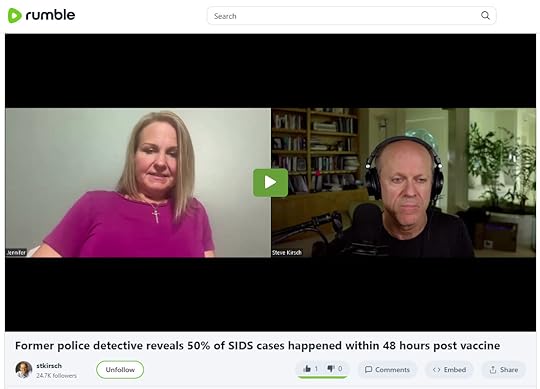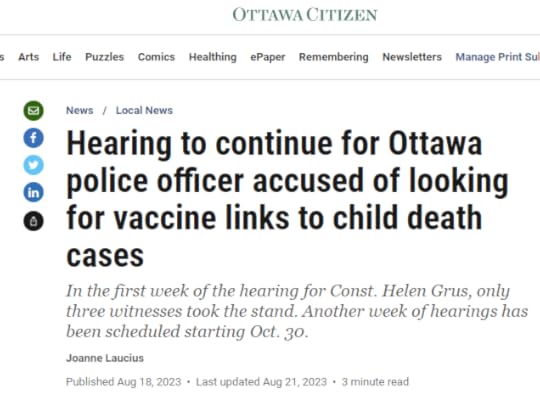Stuart Jeanne Bramhall's Blog: The Most Revolutionary Act , page 361
September 29, 2023
Francis of Assisi and the Mendicant Orders
 Episode 14 St Francis and the Mendicant Orders
Episode 14 St Francis and the Mendicant Orders
1215: Years That Changed History
Dr Dorsey Armstrong (2019)
Film Review
The first Christian hermits and monastic orders appeared in the third century AD. Two hundred years later, the first major monastic order, the Benedictines. Because the monks were expected to be self-sufficient, they engaged in agriculture, collected large tracts of land, became fantastically wealth and involved themselves in local politics.
In 1098, the Cistercian order was started in reaction to the Benedictines’ worldliness. Adopting a rule of poverty, the Cistercians deliberately located their monasteries in rural areas to help their monks resist the temptation to involve themselves in politics. They, too, became extremely wealthy owing to the high quality wool they produced and their involvement.
In 1209, Francis of Assisi, feeling a need for representatives of God to work directly in the community helping people, founded (with the pope’s permission)* the Friars Minor, the first of several mendicant orders.
Born in Assisi (Italy) in 1181, Francis was the son of a cloth merchant who became caught up in an insurrection against the ruling nobility. After he was taken captive at the battle of Perusia, it took over a year for his family to ransom him.
Francis and the other monks in his order deliberately reached out to lepers and other shunned minorities. They begged for alms (mainly food because they weren’t allowed to accept money) and at time building materials to help restore church building.
Thanks to Francis’s meeting with the Sultan of Egypt, and the Franciscans, they are the only Catholic order with an an ongoing presence in the Mideast.
Owing to his love of animals, St Francis became the patron saint of pets and wild animals.
In 1216, the Dominican order was founded. Stressing teaching and education, they played an important role in founding Oxford and Cambridge.
*The pope’s permission was needed for mendicant monks to shave their head in a tonsure. Free travel between towns and villages was illegal in the 13th century without permission from a feudal lord or a tonsure identifying the person a a monk.
September 28, 2023
Kids, Psychotropic Drugs and the Welfare System: A Failure to Regulate

By Christopher O’Donnell, Tampa Bay Times
KFF Health NewsFederal audits in four states uncovered inadequate oversight of the use of psychotropic drugs among foster kids. According to a lawsuit filed in Maryland, as many as 34% of the state’s foster children are given psychotropic drugs but most of them don’t have a documented psychiatric diagnosis.
The powerful anti-seizure drug the 5-year-old boy had been taking for more than a year made him “almost catatonic,” his new foster mom from Florida’s Pinellas County worried.And there was no paperwork showing that the boy’s biological mother or a judge had authorized the psychotropic medication, Keppra, as required by state law.
“I was caught between a rock and a hard spot,” she said. “You can’t just stop that cold turkey.”
The child’s medical records showed he had seizures only when he had a fever, suggesting he was not epileptic. The foster mom asked the boy’s neurologist if they could wean him off the drug.
He has not had a seizure since.
The account from the foster mother was confirmed by the boy’s biological mother, who said she was not asked nor would she have consented to put him on the anti-seizure drug.
The Tampa Bay Times and KFF Health News are not using their names to protect the identity of the boy, who is still in foster care.
The use of powerful psychotropic and opioid medications in Florida’s child welfare system is supposed to be strictly regulated and documented.
However, a federal audit of 115 records of children prescribed those medications selected at random by the U.S. Department of Health and Human Services found lax record-keeping and multiple cases of child welfare workers failing to follow Florida regulations on psychotropic or opioid medication.
Federal audits in Indiana, Michigan and Ohio also uncovered inadequate oversight of the use of psychotropic drugs among foster kids.
In Maryland, the American Civil Liberties Union and other nonprofits filed a class-action lawsuit accusing the state of not maintaining medical records.
The suit says as many as 34% of the state’s foster children are given psychotropic drugs but that most of them don’t have a documented psychiatric diagnosis.
Child advocates fear such examples reflect a national failure to closely monitor the use of drugs among a vulnerable population already more likely to be on medication than other children.
“We shouldn’t have to have a tragedy to make sure the system is paying attention,” said Robin Rosenberg, deputy director of Florida’s Children First, a nonprofit that advocates for kids in foster care.
Medication records missing
More than 2,200 foster children in Florida — roughly 1 in 10 of the state’s foster care population — are given medication typically prescribed for mental health disorders such as schizophrenia, depression, bipolar disorder and attention-deficit/hyperactivity disorder (ADHD), state reports show.
That includes 73 children ages 5 and younger. Among foster children 13 and older, the rate is almost 1 in 3, more than double the rate among similarly aged children in the general population.
But in close to half the cases, auditors found no records of the psychotropic medications prescribed in the case file in the state’s primary case management system.
Logs that record the frequency and dosage of — and any adverse reactions to — psychotropic medication were missing from 66% of the case files reviewed, and authorization records were not found in more than one-third of the case files.
Documentation of the use of opioids was even more lax, with no record of what medication was prescribed in nearly every case reviewed.
The high turnover of case managers in foster care means accurate paperwork is critical, Rosenberg said. Foster children, especially teenagers, often move between different foster families and group homes, which can mean they may be treated by doctors who know little about their medical histories.
That raises the risk of overdoses or dangerous drug interactions, Rosenberg said.
The FDA in 2016 warned that the wrong combination of opioids and psychotropics can result in “serious side effects, including slowed or difficult breathing and death.”
“Doctors need to have correct information to make the best decisions for children,” Rosenberg said.
‘Health and safety may have been at risk’
In response to the audit findings, the Florida Department of Children and Families is looking at more streamlined ways for records to be uploaded into the state’s child welfare system, said spokesperson Miguel Nevarez.
It also plans to enhance its monitoring and is looking to use other sources of data to cross-check the information in case files.
In Florida’s privatized system, the Department of Children and Families contracts with local nonprofits to run the state’s foster care system in 20 distinct districts. The department has an oversight role.
“We will hold the lead agencies responsible for the work they are contracted to do and ensure that they adhere to Department policies,” Nevarez said in an email.
Children with mental disorders are often prescribed a combination of medications, including antidepressants, stimulants, antipsychotics, anticonvulsants, lithium and sedative hypnotics. In foster care, the cost is covered by Medicaid in most cases.
Florida’s child welfare system has long required strict record-keeping for such drugs.
Lawmakers added safeguards after a 7-year-old foster child named Gabriel Myers died by suicide in 2009. At the time of his death, Gabriel had been prescribed two psychotropic medications.
Physicians or psychiatric nurses prescribing medication must complete a medical report and attempt to obtain consent from the child’s parent or legal guardian.
When parents cannot be reached or their parental rights have been terminated, the foster care agency must submit the medical report to a court for authorization.
Case managers are required to document the use of medication, including the prescription name, quantity, number of refills and dosage, and record it in the state’s primary record system within three business days.
Every time a child is given a pill or experiences side effects, it should be recorded on a medication log by the child’s caregiver, according to the Florida Administrative Code.
Case managers are required to obtain the logs at each home visit and add them to the child’s case file.
But that was not happening consistently, the federal review found. One child who was prescribed stimulants and antidepressants had no record of them in their case file.
Other case files had records of some prescribed drugs, but not all.
In another example, medication logs were missing for a child prescribed antipsychotic and anti-anxiety drugs. When asked by federal auditors to provide them using supporting paperwork, the foster care agency could not find any, the report said.
The state relies on these records to flag cases it may need to oversee for psychotropic medication use. When missing, those children’s cases were not monitored, the audit found.
Another concern for auditors was that the Department of Children and Families did not have access to all the state’s Medicaid data that federal auditors used to cross-check case files, meaning it had no way to ensure authorizations were on file.
Also, the training curriculum for child protective investigators and case managers did not specifically address the requirements for maintaining medication logs in the children’s case files, auditors found.
“The State agency could not ensure that children in foster care received the necessary monitoring and care. As a result, the children’s quality of care and health and safety may have been at risk,” the report states.
The Department of Children and Families is working to obtain Medicaid claims data for all children in foster care, Nevarez, the agency spokesperson, said.
The challenge of getting the right care
The review did not look at whether the use of psychotropic or opioid medication was justified. But the lack of oversight has brought renewed scrutiny to the higher rates of medication use in the child welfare system.
Marlene Bloom, a Tampa psychologist who has worked with foster children for 25 years, said it makes sense that a higher proportion of foster kids would need medication.
The children of parents with mental health disorders are more likely to be in foster care and some disorders are genetic, she said.
But she also sees children on medication whose main issue is trauma, either from their home situation or from being removed from their families.
Among foster families, Bloom said, she doesn’t see as much resistance to giving kids medication as she does from the parents of her private clients. They also don’t push to get kids off the drugs as quickly as possible.
“In foster care, if it’s the difference between literally having no placement, or some medication that may not be necessary but does help you to maintain a placement, what’s the right thing to do?” she said.
Jenn Petion, CEO of Family Support Services of North Florida, a nonprofit that serves as the lead foster care agency in Jacksonville and parts of Tampa Bay, said the additional paperwork required to get medication prescribed in the child welfare system can make it harder to give foster kids the same mental health care that is available to other children.
But for some families, the concern is not about lack of care — but about improper care. Dunedin resident Giselle Espinet said she believes her adopted daughter was overmedicated while in Florida’s foster care system. A former high school teacher, Espinet reached out to the foster care system four years ago hoping to adopt a teenager.
[…]
Via https://childrenshealthdefense.org/defender/kids-psychotropic-drugs-welfare-system/
Family Investigated for Keeping Teen Home After School-Based Health Center Gave Bag of Unlabeled Zoloft to 17-Year-Old
 By Brenda Baletti, Ph.D. A federally funded school-based health center (SBHC) in Maine reportedly gave prescription anti-depressant pills in a plastic baggy to a 17-year-old girl without her parents’ knowledge or consent, her father told The Maine Wire.
By Brenda Baletti, Ph.D. A federally funded school-based health center (SBHC) in Maine reportedly gave prescription anti-depressant pills in a plastic baggy to a 17-year-old girl without her parents’ knowledge or consent, her father told The Maine Wire.When the girl’s father, Eric Sack, found the pills — which his daughter told him were Zoloft — he complained to the school.
Zoloft carries a black box warning — which warns of possible serious adverse reactions — indicating the drug can cause suicidal ideation, particularly in people under age 24, when they first start taking the drug.
Sack kept his daughter home from school the following week to make appointments with a doctor and therapist — a decision that resulted in someone at the school or the health center reportedly contacting Child Protective Services, which investigated the family.
The recent push by the U.S. federal government to rapidly expand the number of SBHCs across the country to improve healthcare for children by offering “primary care, mental health care, and other health services in schools” — particularly in underserved communities — is raising red flags.
Critics say they’re concerned children might receive, or be pressured into receiving, unnecessary or unwanted medical interventions without their parents’ knowledge or consent.
Georgia attorney Nicole Johnson, co-director of Georgia Coalition for Vaccine Choice and a consultant to the Children’s Health Defense (CHD) legal team, told The Defender:
“This case in Maine really is everything we worried about. It is almost the worst-case scenario. A young person is getting a drug with a black box warning. They come home with it. It doesn’t even have any warning label on it. The parents haven’t been told, and the drug is in some plastic bag that anybody — any other child in the house, or their peers — could have access to. It could be a very dangerous situation.”
Maine goes all in on SBHCs
The Bulldog Health Center at Lawrence High School in Fairfield, Maine, which reportedly gave the Zoloft to Sack’s daughter, offers primary care services onsite to middle and high school students.
It is operated by Maine’s HealthReach Community Health Centers, a nonprofit funded largely by patient fees and grants. HealthReach reported it also received $4.8 million from the Health Resources and Services Administration (HRSA) of the U.S. Department of Health and Human Services (HHS), although further grant details are not available.
HRSA also awarded approximately $25 million in 2022 to expand 125 SBHCs, including $81,728 to HealthReach. HRSA also awarded $5 million to 27 centers in 2021.
Those grants came in addition to $50 million in HHS grants authorized by the Biden administration and Congress in 2022 to states “for the purpose of implementing, enhancing, or expanding the provision” of healthcare assistance through SBHCs using Medicaid or the Children’s Health Insurance Program, The Defender reported.
In Maine, the Department of Education and Department of Health and Human Services (DHHS) announced in March 2022 plans to expand SBHCs across the state through the use of one-time federal American Rescue Plan funding for $2.4 million.
Funds are being distributed in two-year grants during 2021-24 to establish 12-15 new centers in Maine.
In 2022, there were at least 22 SBHCs in the state.
State funding covers startup costs plus costs for uninsured and underinsured students, for additional time needed during visits and for “confidential care that may not be billed to insurance,” according to a presentation by DHHS.
In the SBHC partnership, the school district acts as the “host,” coordinating enrollment in the SBHC program, parental consent and services. The healthcare provider is the “sponsor,” which receives the funding and provides the services.
A key justification for the expansion of the centers, in Maine and nationally, is an “increased need for mental health care.” The demand for mental health services for children and youth were at “an all-time high,” according to DHHS’ presentation, and the COVID-19 pandemic made disparities in access to healthcare more severe.
In the 2020-21 school year, 77% of the reported SBHC visits were for mental health services. DHHS also indicated that increased emergency department use by youth was driven by suicidal ideation among adolescent females.
‘I’m looking out for the best interests of my daughter’
The Maine Wire reported that when Sack found a zip-close bag containing small blue pills in his family home, his daughter told him she had been prescribed the pills by the Bulldog SBHC.
He said he was concerned the prescription given to his daughter violated his parental rights, but also that the center sent unlabeled drugs with no child-resistant container home with his daughter to a household where two younger children also lived.
Sack said he contacted Lawrence High School Principal Dan Bowers, who told him the clinic was a separate entity that he had no control over.
Sack also said a representative from the Bulldog Health Center told him they could legally prescribe the medication to his daughter without informing him. They did not comment on the lack of a label or safety container, he said.
Concerned, Sack pulled his daughter out of school the following week.
[…]
The Maine Wire reported what happened next:
“On Thursday, an agent from Child Protective Services (CPS) called Sack and informed him that he would be arriving shortly to make a surprise visit to his home to conduct a child welfare investigation.
“‘They called and said it was an emergency situation at my house, that I was pretty near holding my daughter hostage, is what the gentleman that came yesterday told me,’ Sack said.
“‘He had information that only the school and Bulldog Health Center had,’ he said.”
Members of the family were questioned individually and as a group by CPS Agent Dylan Wood, who eventually indicated the complaint against him was unfounded, Sack said.
SBHC consent forms may be confusing for parents
Sack told The Maine Wire that he or his wife may have signed a consent form at the start of the school year, but he still thought the incident violated his rights.
Justine Tanguay, an attorney with nearly 20 years of experience advocating for children in various areas of the law, told The Defender these consent forms are a key issue for parents to be aware of.
At the start of each school year, parents are given many forms to sign and they likely don’t realize they are signing away their rights over their children’s healthcare, she said.
Most parents, she said, tend to assume that school medical consent forms allow a school nurse to administer first aid, treatment for minor illnesses or emergency treatment.
“But that is not what this is,” Tanguay said. “It’s something much more nefarious.”
Unlike school nurses, SBHCs function as primary care clinics. By signing consent forms, parents may unknowingly give those who run the SBHC the legal authorization to provide “comprehensive healthcare.”
This could include — but may not be limited to — “the ability to provide preventative treatment, behavioral and mental health services, reproductive counseling, lab and prescription services, various medical screenings, immunizations and disease management,” Tanguay said.
She said parents should know:
“One form they may receive at the start of the school year is a blanket consent form, and if they sign it, they are basically abdicating their parental rights to make medical decisions for their kids.
“The school won’t need to reach out and ask, ‘Hey, can we test your child for whatever thing?’ No, they’ve signed the form, they’ve already said, ‘Do whatever you want.’”
But, she said, parents who signed such a form have the right to revoke it.
Tanguay added that consent forms can be difficult to understand and the forms are not all the same.
She suggested parents whose children go to schools with SBHCs should find out what the forms they are signing say and decide what they want to opt out of.
Tanguay also said Bower’s alleged statement that the clinic is not under his control is true. These clinics are inside of the school, but are separate entities not administered by the school, she said.
Yet, the school is responsible for obtaining signed consent forms from the parents, which generates confusion.
That means parents are not giving informed consent, Tanguay said.
[…]
Teen mental health crisis spurred federal funding for SBHCs
At least since the start of the COVID-19 pandemic, public health officials and organizations have been sounding the alarm about a mental health crisis among children.
The American Association of Pediatrics (AAP) declared the children’s mental health crisis a national emergency in October 2021 and the surgeon general in May of this year issued a public advisory warning that social media can pose a “profound risk of harm to the mental health and well-being of children and adolescents.”
In fact, suicide rates, particularly among teenage girls, have been on the rise since 2008.
Those public announcements pointed to the COVID-19 pandemic, racism, and social media as the causes of higher rates of mental illness among teens.
But other experts, including Vinay Prasad, M.D., MPH, have cautioned against those assumed links, instead pointing to policies such as lockdowns and school closures that isolated kids and teens and forced them online for large periods of time, compromising their education and their social lives.
Groups like the AAP, a strong supporter of SBHCs, have used the mental health crisis to call on the Biden administration to fund expanded access to screening, diagnosing and treatment for children, arguing access to “school-based mental health care” should be a priority.
The administration responded with new policy measures, including the Bipartisan Safer Communities Act — which made $11 billion available for mental health services — and the American Rescue Plan Act. Both offer funding explicitly for school-based mental health services for students, KFF Health News reported.
Many of these resources have funded the expansion of SBHCs.
Professional associations including the AAP and the American Academy of Family Physicians recommend antidepressants, often combined with therapy, to treat moderate-to-severe mental health issues in young people.
But the use of antidepressants for young people — one tool for addressing mental health issues by the healthcare industry — has been controversial, with many advocates arguing for decades that the “heavily-marketed mind-altering agents” are prescribed too frequently to children and the drugs’ effects are understudied.
A 2016 review of over 70 trials published in The BMJ found an increase in self-harm and aggression in children and adolescents taking antidepressants, but not in adults.
Because of these concerns, the U.S. Food and Drug Administration (FDA) put a black box warning on many antidepressants in 2004, warning that they increase the risk of suicidality (defined as serious thoughts about taking one’s own life or planning or attempting suicide) among children, adolescents and young adults.
[…]
Via https://childrenshealthdefense.org/defender/maine-school-based-health-center-zoloft/
Bill Gates Suddenly Abandons Climate Doom Narrative

By Lance D Johnson
Newstarget
Bill Gates, author of “How to Avoid a Climate Disaster,” spent the last decade warning audiences that the world is overpopulated and subject to impending climate doom. In order to save the planet, Bill Gates says we must achieve “zero net carbon emissions by the year 2050.”
Meanwhile, Gates continues to traverse the world in his private jets, spewing more carbon emissions in one year than the average person does in their entire lifetime.
As more people see through the climate change façade and realize how their lives are being exploited by globalism, Bill Gates is suddenly changing his tune on the climate doom narrative. During a live speaking event at the Times Center in New York, Gates made a sudden U-turn on his climate doom narrative. He said, “No temperate country is going to become uninhabitable.”
Gate’s latest comments are in stark contrast to the public comments he made just two years ago, when his book on climate doom was first published. In a 2021 Fox News Sunday interview with Chris Wallace, Bill Gates said, “The migration that we saw out of Syria for their civil war, which was somewhat weather dependent, we’re going to have 10 times as much migration because the equatorial areas will become unlivable.” Now he suddenly believes the opposite is true, and it’s easy to see why he is softening his stance.
The fear-driven, end-of-the-world climate change doom narrative is no longer working on the masses, and Gates knows that people see through the manipulation and exploitation, so he is adapting his message. In his most recent public speech, Gates said, “If you try to do climate brute force, you will get people who say, ‘I like climate but I don’t want to bear that cost and reduce my standard of living.’” In other words, Gates knows his climate investments are helping to destroy the standard of living for millions worldwide.
The poor and working class are being looted by Bill Gates’ climate change policiesThe poor and working class are the ones who are most impacted by the globalists’ net zero climate change policies and the green new deal energy rationing and money laundering that is taking place globally.
The United Nation’s central planning of agriculture and energy production has stifled both, driving up the cost of food and energy and reducing the standard of living for many. Now, populations are pushing back against socialism, green new deals and the “ESG” (environment, social, and governance) schemes that have infiltrated corporations and governments around the world. These policies have slowed economic growth, increased energy costs and wasted billions of taxpayer dollars.
Fossil fuels still represent approximately 80 percent of U.S. energy production and consumption, so the Biden regime’s attempts to shut pipelines and drilling down has only hurt the poor and working class who depend on affordable energy prices just to get by. In the U.S., the $27 billion “National Climate Bank,” created by Biden’s green new deal, has only led to waste, fraud, abuse and outright socialism. Government central planners (like climate czar John Kerry) are entitled to pick the winners and losers in the economy, stifling market innovation and upending countless jobs and livelihoods. Meanwhile, all this self-destruction of American energy and innovation is making the U.S. more vulnerable to foreign nations like Russia. Russia, not beholden to the UN’s climate change hysteria and population controls, is gaining leverage over the U.S. and Europe with their robust, diversified energy production and transport systems.
For these reasons alone, Bill Gates and the green new deal-pushing globalists are out of touch with reality. Not only are they making it harder for the average person to eat, commute to work and cool/heat their homes, but their delusional polices are also breaking down the sovereignty of nations, making populations more vulnerable and the world less safe in the process.
[…]
Via https://www.newstarget.com/2023-09-25-bill-gates-abandons-climate-doom-narrative.html
Refusing Latest Covid Shot, Top US Government Vaccine Adviser Warns of Long Term Impact of Myocarditis
 by Will Jones
by Will JonesDaily Sceptic
A top vaccine adviser to the U.S. Government has refused to get the latest Covid shot as he warns about the long term impact of myocarditis and other serious side-effects.
In a video posted on X (Twitter) by the ‘Chief Nerd’, Dr. Paul Offit – a member of the Food and Drug Administration’s vaccines committee – said he “didn’t get last year’s bivalent vaccine” and he’s “not getting this year’s vaccine” because he believes he is “protected”.
Dr. Paul Offit on Why He Is Not Getting This Year's COVID Booster, Says Myocarditis Could Last Longer Than Previously Thought
"I think I'm protected. I didn't get last year's bivalent vaccine. I'm not getting this year's vaccine because I think I have high frequencies of… pic.twitter.com/oavTzHGQFq
— Chief Nerd (@TheChiefNerd) September 25, 2023
We’re going to find out about this vaccine over time,” he warns, describing the whole approach as a “novel strategy”.
We certainly were surprised by myocarditis and pericarditis and we’ll see whether or not over time when we’re five years into this, 10 years into this, 15 years into this, whether there’s any evidence of residual myocardial disease because the reason you have myocarditis is you’re making immune response to your own heart muscle… We’ll find out about that over time.
Dr. Offit has previously been a cheerleader, not only for the Covid vaccines but for the vaccine mandates that forced millions of Americans to get the shots or quit their careers.
Defending the first New York City vaccine mandate in summer 2021, he animatedly told CNN that “it is not your right as an American citizen to catch and transmit a potentially fatal infection”.
However, he changed his tune at the start of this year when he wrote in the New England Journal of Medicine an article sharply criticising the bivalent vaccines being rolled out at the time, branding them a “cautionary tale”.
At that point he did not mention safety worries, so his raising of concerns about myocarditis and other adverse effects is a new development.
As Dr. Offit says, we’re going to find out about this vaccine over time. Dr. Offit has been complicit in inflicting this rushed, under-tested technology on America and the world. However, he is a rare example of someone in a key advisory position willing to change his tune publicly. Will others be inspired to follow him?
[…]
Cholesterol Does Not Cause Heart Disease

Dr Mercola
Story at-a-glanceCholesterol, long vilified as the cause of cardiovascular disease, is a vital component to nearly every cell in your body for the construction of cell membranes, regulation of cell signaling and neurological healthA review of three large industry-funded studies found it was impossible for cholesterol to be the main cause of heart disease as those with low levels had the same levels of arterial sclerosis as those with high levelsThe same study found benefits claimed by statin supporters are ineffective and unsafe, as statements are invalid, compromised by misleading statistics and excluding information from unsuccessful trialsHeart disease is driven by a chronic inflammatory response in your body you may impact through adequate intake of magnesium, reducing insulin secretion, balancing omega-3 and omega-6 fat ratio and maintaining iron levels in safe limitsCholesterol is a waxy substance found in nearly every cell of your body, vital for optimal functioning. For instance, your body uses cholesterol in the construction of cell membranes and in regulating protein pathways required for cell signaling. Without sufficient amounts of cholesterol in your body you may experience a negative impact on your brain health, hormone levels and heart disease risk.
Your body also uses cholesterol to manufacture vitamin D after exposure to the sun. Most of the cholesterol in your body is manufactured in your liver using nutrients extracted from your food. Animals use cholesterol in much the same way, which means meat from beef, pork or chicken have similar levels.1
The rate your body absorbs dietary cholesterol ranges between 20 and 60%, depending on individual factors.2 Unfortunately, while critical to your health, saturated fats and cholesterol have been wrongly vilified as the culprits of heart disease for more than six decades.
The first scientific evidence linking trans fats to heart disease and exonerating saturated fats was published in 1957 by the late biochemist Fred Kummerow.3 Unfortunately, his research was overshadowed by Ancel Keys’ Seven Countries Study,4 which linked saturated fat to heart disease.
Later, reanalysis of Keys’ study revealed the data was cherry picked to produce this link, but by then the saturated fat myth was already firmly entrenched. In the past several decades, other studies have debunked the saturated fat myth.
Most recently, a scientific review5 identified significant flaws in three industry-funded studies, and presented substantial evidence that total cholesterol and low-density lipoprotein (LDL) cholesterol levels are not an indication of heart disease risk.
Yet Another Study Busts the Cholesterol MythGuidelines published for eating fats continue to be confusing as the basic premise was wrong. Dietary fat is associated with heart disease, but it is processed vegetable oils loaded with trans fats and damaged omega-6 fats that are producing the problem, not saturated fats.
An international team of 17 experts analyzed the results from three large reviews published by statin advocates. The three studies attempted to validate the current belief that statin treatment helps prevent cardiovascular disease. The international team was unable to satisfy criteria for causality and found fault in the conclusions the three studies made.6
The international team wrote there may be an association between young and middle-aged people with high total or LDL cholesterol that may potentially raise the risk of heart disease.
However, they point out an association is not the same as causation, and few previous studies have adjusted for other factors linked to heart disease such as coagulation, inflammation, infections and endothelial sensitivity. Specifically, the authors found:7
There was no association between total cholesterol and the degree of atherosclerosis severity.Total cholesterol levels are generally not predictive of the risk of heart disease and may be absent or inverse in many studies.In many studies LDL was not associated with atherosclerosis and in a large U.S. based study of nearly 140,000 patients who suffered an acute myocardial infarction, LDL levels at the time of admission were lower than normal.Adults over the age of 60 with higher LDL levels generally live longer.Few adults who experience familial hypercholesterolemia die prematurely.The researchers concluded that high cholesterol levels cannot be the main cause of heart disease as those with low levels have nearly the same degree of sclerosis as those with high levels, and the risk of having a heart attack is the same or higher when cholesterol levels are low.
They believe the hypothesis has been kept alive by reviewers using misleading statistics and excluding results from unsuccessful trials while ignoring numerous contradictory observations.8
Statins Raise Risks Without BenefitsIn dire cases, physicians may prescribe a medication with significant side effects when the potential benefits outweigh the possible risks, such as a strong antibiotic known to potentially trigger kidney damage when you suffer a life-threatening infection. In this instance, although there is significant risk with the antibiotic, without it you will likely die.
However, as statin drugs are designed to reduce cholesterol levels and cholesterol does not cause heart disease, all risks associated with the medication come without any benefit to your health. The trend for prescribing statin drugs is concerning, and is particularly relevant to diabetics whose underlying disease increases their risk of heart disease.
Recommendations suggest high dose statins should be automatically started in anyone 40 to 75 years of age with diabetes but no other risk factors for heart disease.9 This, despite the fact that statins have been shown to increase fasting blood glucose levels in diabetics.10 While statin supporters claim the drug is safe and effective, research has uncovered multiple side effects, some of which are deadly:11,12
General — Urinary tract infections, dizziness, partial loss of sensitivity to sensory stimuli, distortion of the sense of taste, amnesia and headacheGastrointestinal — Diarrhea, indigestion, nausea, intestinal gas, constipation, abdominal discomfort, abdominal pain, vomiting and pancreatitisMetabolic — Abnormal liver function tests, hyperglycemia, hepatitis, anorexia, hypoglycemia and weight gainMusculoskeletal — Joint pain, pain in extremity, musculoskeletal pain, muscle spasms, myalgia, joint swelling, back pain, elevated creatine phosphokinase, neck pain and muscle fatigue, muscle wasting and amyotrophic lateral sclerosis (ALS)13Cardiovascular — Death in up to 10% of patients,14 contributes to heart disease15Strikingly, the expert reviewers in the featured study noted claims of effective and safe treatment with statin drugs are invalid, saying:16
Inflammation Drives Cardiovascular Disease“In our analysis of three major reviews, that claim the cholesterol hypothesis is indisputable and that statin treatment is an effective and safe way to lower the risk of CVD [cardiovascular disease], we have found that their statements are invalid, compromised by misleading statistics, by exclusion of unsuccessful trials, by minimizing the side effects of cholesterol lowering, and by ignoring contradictory observations from independent investigators.”
Biased research launched a low-fat myth and reshaped the food industry for decades to come. As saturated fat and cholesterol were rejected, manufacturers switched to using trans fats and sugar to add taste to processed foods. These changes increased inflammatory levels and drove a new level of disease.
A study from Brigham and Women’s Hospital was the culmination of a nearly 25-year cardiovascular research work designed to test if reducing inflammation would also reduce the risk of recurrent heart attack or stroke. The study enrolled 10,000 people with a history of heart attack and a persistently elevated C-reactive protein level, a strong biomarker of inflammation.
At the conclusion of the study, the researchers noted that using medication to reduce inflammation also reduced the risk of cardiovascular disease, lung cancer and death.17 However, the medications used in the study came with significant side effects. In contrast to acute inflammation after an injury, chronic inflammation does not produce immediate symptoms.
Over an extended period of time, chronic inflammation silently damages your tissues and arterial walls, which your body attempts to repair. These repairs may build over time and create plaque, potentially breaking off and blocking smaller arteries in the heart or brain, triggering a heart attack or stroke.
This process may go on for years without being noticed, as chronic inflammation has few apparent symptoms. Research has demonstrated deficiencies and excesses of certain micronutrients, such as folate, vitamin E and zinc, may result in an ineffective or excessive inflammatory response. Researchers note:18
“Inflammation acts as both a ‘friend and foe’: it is an essential component of immunosurveillance and host defense, yet a chronic low-grade inflammatory state is a pathological feature of a wide range of chronic conditions, such as the metabolic syndrome, nonalcoholic fatty liver disease, Type 2 diabetes mellitus and CVD.”
[…]
Manage Your Heart Disease Risk With Effective ChoicesTo effectively manage your cardiovascular risk, it is critical to reduce chronic inflammation. Magnesium plays a vital role in biological function and mitochondrial health, and is a culprit in the development of inflammation when your levels are low. It may also play a role in inhibiting the deposit of lipids on arterial walls and plaque formation.21
In one double-blind, placebo-controlled trial, patients who received intravenous magnesium within 24 hours of their heart attack experienced 24% fewer deaths within the following five years.22 Researchers concluded the benefits of magnesium intake on chronic disease may be explained by the effect it has on inhibiting inflammation.
There are multiple factors affecting the inflammatory process in your body. Some of the more significant over which you have control, include:
• Hyperinsulinemia — An excess of insulin in your blood triggered by a diet high in net carbohydrates. What you eat tends to be the deal-breaker in how much insulin your body secretes. However, there are other factors contributing to your insulin levels, such as smoking, sleep quality, exercise and vitamin D level.
• Unbalanced fatty acids — Your body needs a balance of omega-3 and omega-6 fats. Unfortunately, most diets have an overabundance of omega-6 fats leading to greater levels of inflammation. Strive for a 1-to-1 ratio of omega-3 to omega-6 fats to reduce inflammation and your risk of heart disease.
• High iron stores — Ensure your ferritin blood levels are below 80 ng/ml. If elevated, the simplest and most efficient way to lower your iron level is to donate blood. If you can’t donate, then therapeutic phlebotomy will effectively eliminate the excess iron.
• Leaky gut — Food particles and bacteria leaking from your intestines increase your level of inflammation and your risk of heart disease. By eliminating grains, sugars and lectin-rich legumes, while adding fermented foods, you may heal your gut and reduce your level of inflammation.
• Inadequate levels of magnesium — A century ago your diet provided nearly 500 milligrams (mg) of magnesium per day. Today, courtesy of nutrient-depleted soil, you may be getting only 150 mg per day. Your body flushes excess magnesium through your stool, so using magnesium citrate and monitoring stool consistency, consider starting with 200 mg of oral magnesium citrate and gradually increasing until you develop slightly loose stools.
[…]Via https://articles.mercola.com/sites/articles/archive/2023/09/28/high-cholesterol-heart-disease-myth.aspxSeptember 27, 2023
Government COVID Vaccine Contracts Shrouded in Secrecy
 Maryanne Demasi, PhD
Maryanne Demasi, PhDMajor international governments have signed multibillion-dollar legal contracts with drug companies in order to secure access to covid-19 vaccines.
But the drug companies and governments have refused to divulge details, saying the information is “commercial in confidence.”
In 2021, we got our first peek at contracts between Pfizer and various international countries after they were leaked to The Bureau of Investigative Journalism and US consumer group Public Citizen.
“The contracts offer a rare glimpse into the power one pharmaceutical corporation has gained to silence governments, throttle supply, shift risk and maximise profits in the worst public health crisis in a century,” said Zain Rizvi, author of the Public Citizen report.
Pfizer was accused of “bullying” governments during contract negotiations, asking some Latin American countries to put up sovereign assets, such as embassy buildings and military bases, as a guarantee against the cost of any future legal cases.
High court decisionLast month, a South African NGO called Health Justice Initiative, won a high court challenge to gain access to all of South Africa’s covid-19 vaccine contracts.
Tony Nikolic, an Australian solicitor from law firm Ashley, Francina, Leonard & Associates, reviewed the Pfizer contract and says it reads like South Africa was “held to ransom” over the deal.
“It’s a one-sided contract. Pfizer gets all of the profits and none of the risks,” says Nikolic. “It’s akin to extortion, there’s absolutely no liability for the vaccine manufacturer in terms of injuries that may arise from their product.”
The South African government agreed to “indemnify, defend and hold harmless” Pfizer and all its affiliates from “any and all suits, claims, actions, demands, losses, damages, liabilities settlements, penalties, fines, costs and expenses” arising from the vaccine.
It also says the government will “create, dedicate, and maintain a no-fault compensation fund sufficient to undertake and completely fulfil the indemnification obligations….. for damage, injury, or harm arising out of, relating to, or resulting from the development, administration, or use of the vaccine.”
Nikolic says, “It’s like the manufacturers could ask for anything they wanted. There was such panic at the time and images in the media of people dying in the streets created a real sense of fear and insecurity around the world.”
The protection against liability is not only in place for the initial vaccine formulation, but for “any or all related strains, mutations, modifications or derivatives of the foregoing that are procured by Purchaser.”
“What this means,” explains Nikolic, “is that Pfizer can modify its vaccine to match whatever variants emerge, and still have all the same protections against liability. This is nothing more than a cash cow for Pfizer, they are privatising the profits, whilst socialising the costs.”
Pfizer charged the South African government $10 per dose, which is nearly 33% more than the $6.75 “cost price” it reportedly charged the African Union.
“In my view, this is why Pfizer wants the details kept secret, so that it can protect the various price differences between countries. It’s classic price gouging with a predatory twist, that is why procurement transparency is essential,” says Nikolic.
Long-term safety?The contract states “the long-term effects and efficacy of the vaccine are not currently known and that there may be adverse effects of the Vaccine that are not currently known.”
Nikolic says this is in stark contrast to the public health messages at the time.
“We had politicians and key opinion leaders telling people that the vaccines were ‘safe and effective’ when the procurement contracts themselves did not make such claims,” says Nikolic.
“The contract clearly indicates that adverse effects were unknown at the time of signing. The burden of proof should never have been on the people to prove the vaccine was unsafe, it should have been on the manufacturer to prove the vaccine was safe,” he adds.
Nikolic has spent the last two years trying to access the procurement contracts signed by the Australian Government.
“Australians are still in the dark about what is contained within these contracts. We know it gave liability protection to the vaccine manufacturers like other countries, but that’s the extent of it,” says Nikolic.
“We need to know what our politicians knew at the time of signing the deal. And we need to know how much money we, the taxpayer, spent for a vaccine that turned out to be far less safe or effective than promised,’ he adds.
In a recent Australian Senate committee hearing, Queensland Senator Malcolm Roberts grilled Pfizer executives under oath about the indemnity clauses in its contract with the Australian government, but Pfizer refused to give details.
“The contents of Pfizer’s contract with the Australian Government remains confidential,” said Pfizer Australia’s medical director Krishan Thiru.
In 2021, Nikolic mounted a legal challenge against covid-19 vaccine mandates in the NSW Supreme Court where he tried to subpoena the Pfizer contract, but his request was blocked.
Undeterred, Nikolic submitted an FOI request to the Australian Department of Health.
The FOI request, however, was denied because the contracts “contain information that is confidential in nature” such as “trade secrets and commercially valuable information.” It stated;
“The documents contain commercial information regarding the procurement of vaccines to Australia. The documents contain information specifically relevant to the unique commercial arrangements between the department and third parties, including indicative prices, payment terms, professional indemnity, ongoing funding measures, manufacturing details and production measures.”
Nikolic says, “It’s unethical, potentially unlawful and immoral for them to argue that the right to preserve commercial confidence overrides the right for public safety, it just doesn’t make sense.”
He adds, “It just boggles the mind how governments just rolled over and entered into agreements with companies like Pfizer that have a long track record of breaching the False Claims Act resulting in billion-dollar criminal and civil liability.”
[…]
Via https://maryannedemasi.substack.com/p/the-secrecy-of-covid-19-vaccine-contracts
Boeing and Seattle Spar Over $1 Billion Pricetag to Get PCBs, Heavy Metals Out of City’s Only River

Duwamish River People’s Park & Shoreline Habitat. Photo credit: Richard Droker/flickr
By Lulu Ramadan, The Seattle Times
Boeing has been dumping chemicals into the river for decades. In court papers accusing the aircraft manufacturer of trying to slough off its share of the cleanup bill, the Port of Seattle said the total cost could top $1 billion — more than double any estimate previously made public. Boeing is in negotiations over how to split the cost with the city, adjoining King County and the Port of Seattle, potentially leaving Seattle taxpayers on the hook.
In its early days as a major aircraft manufacturer, Boeing was remarkably open about toxic chemicals flowing from its factory into the neighboring Duwamish River, Seattle’s only river and a longtime source of food, tradition and culture for Indigenous people.
In fact, the company described the Duwamish River as “a natural collector for Boeing’s fluid wastes” in a 1950 magazine article Boeing produced for its employees.
Boeing said at the time that it had a handle on the situation — asserting, for example, that some of its most volatile waste would be neutralized by chemicals released by other polluters.
Today the waterway is among the nation’s most contaminated, a full-scale cleanup is scheduled to begin next year, and Boeing is deep in negotiations over how to split the cost with other leading landowners on the river: the city, adjoining King County and the Port of Seattle.
As with most negotiations conducted under the nation’s Superfund cleanup law, the parties agreed long ago to keep details of their talks secret. But a short-lived lawsuit, filed by the port last year and withdrawn in June, offered a glimpse of a staggering dollar figure that’s never been part of the public discussion.
In court papers accusing Boeing of trying to slough off its share of the cleanup bill, the port said the total cost could top $1 billion. The sum is more than double any estimate previously made public, and it would make the Duwamish one of the nation’s costliest cleanups on record. Government websites still put the cost at about $340 million.
The dollar amounts alluded to in the 2022 lawsuit point to a high-stakes and largely hidden deliberation between the region’s biggest government players and a major company born in Seattle more than a century ago.
Whatever the parties agree to, taxpayers may never know whether the cost split was fair because how the decision was reached is intended to remain secret.
This month, in response to questions from The Seattle Times and ProPublica, Boeing said it was the port that was refusing to do its part.
[…]
Boeing declined to comment on the private negotiations or disclose the exact amount it agreed to pay, but it said that the company expects to spend “hundreds of millions of additional dollars.”
This summer, Boeing joined with the city and county in issuing a separate statement saying the lawsuit’s allegations do not affect their “ongoing and lasting commitment to restoring the water quality of the Lower Duwamish for people, salmon, and orcas.”
[…]
The port continues to claim, as it did in its lawsuit against Boeing, that negotiations could saddle taxpayers with “tens of millions of dollars” in costs for which the company is liable.
Meanwhile, people who have waited for the Duwamish to be restored say they worry about the lack of information available to the public.
Local government agencies and Boeing have spent more than $200 million cleaning up “early action” sites in the Duwamish Superfund area since 2001. A full-scale cleanup is scheduled to begin next year. The Port of Seattle says it could cost $1 billion, which would make it one of the nation’s costliest Superfund cleanups.
Two centuries ago, as white settlers began to develop the land, Native tribes successfully negotiated for their fishing rights on the Duwamish River to preserve a cultural touchpoint and vital food source.
The city of Seattle eventually recognized the river’s value as a pathway for transporting cargo. It scraped away the winding river’s marshy banks, straightened its natural bends and dredged its floor.
What was once a complex ecosystem of mudflats, native plants and spawning fish became a sprawling industrial corridor.
Boeing found a home along the Duwamish in 1916, launching an operation from an abandoned shipyard where it built seaplanes. In the 1930s, the company developed the nation’s first four-engine bomber and the federal government eventually ordered about 7,000 B-17s over the course of World War II. By the end of the war, Boeing’s plant along the Duwamish expanded to nearly 1.7 million square feet.
It ultimately became one of the largest landowners in the industrial district, but publicly owned facilities also contributed toxins: water runoff tainted with chemicals from the city’s steam plant, pollution from the port’s cargo terminals and unfettered sewage dumped from King County’s wastewater system.
The river is now contaminated with heavy metals and cancer-causing chemicals, including polychlorinated biphenyls (PCBs) and polyaromatic hydrocarbons (PAHs).
Along the river now are large health advisory signs warning the public not to eat bottom-feeding fish and to limit consumption of certain salmon, a warning system King County calls “Fun to Fish, Toxic to Eat.”
Even direct contact with river mud is a risk, the state health department warns. Tribal fishing, protected by an 1855 federal treaty, continues along the river despite declining fish populations and public health warnings.
Some of these contaminants can be traced to Boeing’s plants along the river, which is why the federal government has named it as one of the major responsible parties.
Boeing’s 1950 magazine article, brought to light in the port’s lawsuit, described its efforts to curb pollution, but the company openly acknowledged that “any unrestrained liquid emptied on the Boeing premises is bound sooner or later to get into the Duwamish.”
Tracy Collier, a toxicologist who worked at the National Oceanic and Atmospheric Administration’s (NOAA) Northwest Fisheries Science Center for three decades and who read the magazine article at The Times’ request, said that it makes legitimate scientific arguments about how pollutants can be diluted and neutralized, but that it’s impossible to tell from the description alone whether Boeing successfully reduced the amount of contamination.
It’s also important to note, Collier said, that some contaminants now found in high concentrations in the river weren’t on the radar 70 years ago. Boeing is one of the parties known to have contributed PCBs, for example, according to the State of Washington’s Department of Ecology.
“We didn’t know in 1950 that PCBs were going to be persistent and as toxic as they are,” Collier said. The chemical wasn’t banned by the U.S. Environmental Protection Agency (EPA) until the 1970s.
Boeing said in a statement that its article described disposal practices that were the industry standard at the time. The company added that it proactively took the steps described in the article before federal and state environmental laws took effect.
In early 2000, a survey by the EPA revealed that the river was eligible for Superfund designation, meaning it was one of the most polluted sites in the country.
The Superfund, created by Congress in 1980, was meant to address the nation’s legacy of toxic industrial waste by establishing a process to pay for cleanups. It was also known to result in costly legal battles. The port, city, county and Boeing hoped to divvy up the tab and clean the river without triggering the Superfund process.
“They were worried about the stigma it would cast on the city, and some believed that they could clean the river up faster and better without EPA dogging their efforts,” BJ Cummings, community engagement manager for the University of Washington’s Superfund Research Program, wrote in her book “The River That Made Seattle,” which details the Duwamish’s history.
However federal environmental regulators needed to sign off. They wanted an agreement that would allow them to go after polluters for damage up to three years after completion of the cleanup, just as they could under the Superfund.
Boeing would not agree. The company told a Times reporter in 2000 that it caused only a small part of the pollution and was worried that it would be stuck with a big share of the cleanup.
[…]
Via https://childrenshealthdefense.org/defender/duwamish-river-seattle-boeing-toxic-chemical-dumping/
Fauci Secretly Met With CIA to ‘Influence’ COVID Origins Investigation
 By John-Michael Dumais
By John-Michael Dumais Dr. Anthony Fauci was secretly escorted into CIA headquarters to “influence” the investigation on COVID-19 origins, according to Rep. Brad Wenstrup, chairman of the House Select Subcommittee on the Coronavirus Pandemic, which opened a new investigation and requested related documents from the U.S. Department of Health and Human Services.
Dr. Anthony Fauci visited CIA headquarters to “influence” its COVID-19 origins investigation, according to allegations disclosed Tuesday by Rep. Brad Wenstrup (R-Ohio).
Wenstrup, in a letter to Inspector General Christi Grimm at the U.S. Department of Health and Human Services (HHS), said he had information suggesting Fauci was “escorted” into CIA headquarters “without a record of entry.”
Wenstrup is chairman of the Select Subcommittee on the Coronavirus Pandemic. A subcommittee spokesperson told the Daily Mail the committee “has received information from multiple sources across multiple agencies regarding Dr. Fauci’s movements to and from the CIA.”
Neither Wenstrup nor any subcommittee member or spokesperson identified specific date(s) Fauci is alleged to have visited the agency.
Tuesday’s press release from the Committee on Government Oversight and Accountability, which is overseeing the subcommittee’s investigation, called attention to allegations by six CIA whistleblowers that they received “significant financial incentives” to change their stance that the SARS-CoV-2 virus may have leaked from the Wuhan Institute of Virology (WIV) in China.
In light of evidence uncovered earlier this year establishing Fauci’s involvement in the “Proximal Origin” paper claiming to disprove the lab leak theory, the subcommittee said it found Fauci’s presence at the CIA “questionable,” alleging it “lends credence to heightened concerns about the promotion of a false COVID-19 origins narrative by multiple federal government agencies.”
Wenstrup asked Grimm to send the subcommittee by no later than Oct. 10 any documents and communications related to Fauci’s movements between Jan. 1, 2020, and Dec. 31, 2022, into any facilities owned, operated or occupied by the CIA.
Wenstrup also requested the pay and bonus history of all past and current members of HHS’ “COVID Discovery Team(s)” and information about staff and contractors at HHS, National Institute of Allergy and Infectious Diseases (NIAID) and the U.S. Marshals Service who may have been involved.
“Our goal is to ensure the scientific investigative process regarding the origins of COVID-19 was fair, impartial, and free of alternative influence,” Wenstrup stated.
Wenstrup did not reveal the source of the information on Fauci’s CIA visit, but the letter mentioned HHS’ Special Agent Brett Rowland, requesting Grimm make him available for a “voluntary transcribed interview.”
A joint letter from the subcommittee and the House Permanent Select Committee on Intelligence Chairman Mike Turner (R-Ohio), sent Sept. 12 to CIA Director William Burns, outlined the testimony of a “multi-decade, senior-level, current agency officer” alleging six of the seven analysts investigating the COVID-19 origins were given a “significant monetary incentive to change their position.”
According to the unidentified whistleblower — a decorated and long-serving CIA officer with expertise in Asia, according to the Substack Public — the six analysts, all with significant scientific expertise, were paid off in order to bury their findings that COVID-19 most likely originated from the Wuhan lab.
The seventh and most senior member of the team was alone in believing the virus had a zoonotic origin, the letter stated.
The CIA whistleblower said, “Fauci’s expert opinions were a significant consideration and were part of our classified assessment … His opinion substantially altered the conclusions that were subsequently drawn,” Public reported today.
“He came multiple times and he was treated like a rockstar by the Weapons and Counter-Proliferation Mission Center. And, he pushed the Kristian Anderson [‘Proximal Origin’] paper,” the whistleblower added.
In a separate letter, the subcommittee also requested Andrew Makridis, former COO at the CIA who was known to have taken part in the investigations, participate in an interview.
Democrats from both committees told ABC News they “were given no prior notice of a whistleblower’s existence, let alone testimony. Without further information regarding this claim from the Majority, we have no ability to assess the allegations at this time.”
CIA Director of Public Affairs Tammy Kupperman Thorp told the New York Post, “At CIA we are committed to the highest standards of analytic rigor, integrity and objectivity. We do not pay analysts to reach specific conclusions. We take these allegations extremely seriously and are looking into them.”
In June, the Office of the Director of National Intelligence (ODNI) declassified a 10-page report on its investigation into the links between the Wuhan lab and COVID-19. In the report, the ODNI admitted the lab performed genetic engineering of coronaviruses, that people working at the lab got sick in December 2019 “consistent with but not diagnostic of COVID-19,” and that they found a lack of “adequate biosafety precautions.”
However, the ODNI report stated the CIA remained “unable to determine the precise origin of the COVID-19 pandemic,“ but that “almost all IC [intelligence community] agencies assess that SARS-CoV-2 was not genetically engineered” and that “all IC agencies” determined the virus “was not developed as a biological weapon.”
In February, the U.S. Department of Energy issued a “low confidence” assessment that the virus most likely originated from the leak at the Wuhan lab.
Several days later, FBI Director Christopher Ray, during an interview with Fox News, said the bureau believed the pandemic was likely the result of a lab accident in Wuhan.
Fauci’s alleged visit to the CIA is the latest data point in a growing body of evidence gathered by the subcommittee investigating the pandemic showing the former NIAID director played a central role in directing and influencing the official COVID-19 origin narrative, chiefly by suppressing the lab leak theory.
Tuesday’s announcement included a link to the subcommittee’s July report, “The Proximal Origin of a Cover-Up: Did the ‘Bethesda Boys’ Downplay a Lab Leak?”
In the “Proximal Origin” paper, prompted by Fauci in early 2021 and written by Kristian Anderson, Ph.D., professor of Immunology and Microbiology at Scripps Research, Anderson and his co-authors argued the virus was not laboratory-made or purposefully manipulated, and that the lab leak scenario was implausible.
The subcommittee report stated the “Proximal Origin” paper has been accessed 5.84 million times and was “one of the single most impactful and influential scientific papers in history” that was used to “downplay the lab leak hypothesis and call those who believe it may be true conspiracy theorists.”
The report further alleged Fauci was aware of the monetary relationship between NIAID, EcoHealth Alliance, and WIV, and that he funded gain-of-function research on coronaviruses at the WIV.
After reviewing more than 8,000 pages of documents and 25 hours of testimony, the subcommittee concluded that “‘Proximal Origin’ employed fatally flawed science to achieve its goal … to kill the lab leak theory.”
[…]
Via https://childrenshealthdefense.org/defender/anthony-fauci-cia-covid-origins-brad-wenstrup/
Former major city police detective reveals 50% of SIDS cases occur within 48 hrs post vaccine

Steve Kirsch
The best way to prevent SIDS is to stop vaccinating kids. In every study published in the medical peer-reviewed literature comparing fully vaccinated with fully unvaccinated children in the US, the fully unvaccinated kids were dramatically healthier with far fewer chronic diseases including autism. In 2009, nine House members co-sponsored a bill to require the NIH to do a study that would show this, but the bill never made it out of committee. Congress doesn’t believe that the American public want to know the truth about the childhood vaccines.
Executive summarySudden Infant Death Syndrome (SIDS) happens to babies, from 1 month to 1 year in age, but most frequently between 2 and 4 months of age.
Recently I interviewed a former police detective who handled over 250 SIDS cases for a major US city. She revealed her full name and I was able to independently verify her employment at the police department.
In the interview, she revealed that 50% of the SIDS cases happened within 48 hours after a vaccine was given and about 70% of the cases happened within one week of a vaccine.
This can only mean one thing: that the childhood vaccines are the leading cause of SIDS deaths.
There is no other explanation.
Even her pediatrician acknowledged this, but they aren’t allowed to talk about it. She said that the American Academy of Pediatrics trains the pediatricians in how to gaslight parents who seek to blame the vaccine.
This is the first time these statistics have ever been revealed publicly.
All the information is independently verifiable in the police records for any health authority who has any doubts.
Also, I am working with the police department to make these statistics public directly from the police department itself (I cannot compel the production of these records because the FOIA laws in the state exempt these records).
My 16-minute interview

[…[
Jennifer’s SIDS statistics are validated in the peer-reviewed medical literature!This paper, Vaccines and sudden infant death: An analysis of the VAERS database 1990–2019 and review of the medical literature, states this:
Of all reported SIDS cases post-vaccination, 75 % occurred within 7 days (p < 0.00001).
This almost exactly matches what Jennifer said in my interview (70% within one week). Neither of us was aware of this article at the time we made the video.
This is impossible if the vaccines aren’t causing SIDS. There is simply no other viable explanation for the association. But of course, you won’t get your paper published if you say that. You have to say that the association is interesting.
Paper by CDC authors observes that nearly 80% the child deaths reported in VAERS happened after multiple vaccinations were given on the same dayIn Deaths Reported to the Vaccine Adverse Event Reporting System, United States, 1997–2013, the CDC authors admit that “for child death reports, 79.4% received >1 vaccine on the same day.”
Jennifer is not the only police detective to figure out the connection; Helen Grus in Ottawa found the same thingIn Canada, if you are a police officer and suspect that vaccines cause SIDS, they will prosecute you. It seems that is illegal in Ottawa to question the safety of the vaccines:

Helen Grus is a Forensic Police Detective in Canada who was looking into the sudden infant deaths that appeared to be connected to mothers being vaccinated.
For the last 2 years she was stonewalled by her own police force. Her court case resumes Oct 2023 and will drag into 2024.
She is being prosecuted for seeking the truth. I hope that Detective Helen Grus will be exonerated and continue to investigate the “baffling mystery” of dead babies.
She was suspended without pay for not taking the COVID vaccine and she doesn’t think masks are effective either.
[…]
How do they explain a 2X to 3X rise in SIDS in 2021 vs. 2020?Watch this video starting at 0:56 which points out that there was a 2X to 3X increase in SIDS cases after the vaccines rolled out. Are you surprised? This is what got Helen’s attention.
A case history of how vaccines cause SIDS and that the medical examiners are gaslighting parentsRead this article. It describes how Sawyer, just 8 weeks old, died just 34 hours after a series of vaccines. The police suspected the parents were at fault and the medical examiner said the death was caused by improper sleeping position and refused to do any tests that might implicate the vaccine. The psychiatrist also told the mom she had an “adjustment disorder.” Four months later, a pathologist ordered the requested tests be done, and it clearly implicated the vaccines as the cause of the SIDS death.
Vibrant LifeAutopsy Confirms Infant Died From Over-VaccinationA toxicology report shows that a new mom in Maine was right. Her baby, Sawyer, died when he was just eight weeks and six days old, just 34 hours after being vaccinated. On October 20, 2022, Melissa, who herself is a registered nurse, took her baby to the pediatrician. Baby Sawyer had a rash around his torso that just wouldn’t go away. The pediatrician di…[…]Peer-reviewed literature says the more vaccines, the higher infant deaths. The r value is a stunning .992. You rarely a correlation coefficient this close to 1 in any real-world data.The peer reviewed medical literature says this: “The mean IMRs of all nations within each group were then calculated. Linear regression analysis of unweighted mean IMRs showed a high statistically significant correlation between increasing number of vaccine doses and increasing infant mortality rates, with r = 0.992 (p = 0.0009).”
In plain English, yes, the more vaccine doses, the higher the infant mortality rates.
[…]
A real world experiment in New ZealandThirty years ago in New Zealand the vaccine schedule was changed from the first being at 3 months down to 6 weeks. SIDS moved with it.
Hilary Butler in New Zealand compiled a gold mine of information as she ran the “Immunisation Awareness Society” at that time and published a monthly newsletter.
A real world experiment in the USFrom the comments:
Seven more studies showing vaccines cause SIDS compiled hereIn 2020 when we were locked down at least through June, Nicole DeGraf, the former executive director of Oregonians for Medical Freedom, and myself, looked at the infant deaths under the age of 1 through the first six months of that year. All medical procedures, including well baby visits were cancelled through the end of June. The number of infant deaths during that period of time dropped to 42% of the ten year annual average of infant deaths in the state.
See Vitamin D wiki which was instantly updated to add a link to this article as well.
The connection between vaccines and SIDS has been known for decadesViera Scheibner, a Slovak research scientist living in Australia, accidentally discovered during her testing of baby monitors that babies were dying soon after receiving vaccines.
She published this in a book on 1993, “Vaccinations: 100 Years of Orthodox Research Shows that Vaccines Represent an Assault on the Immune System
[…]
Scheibner stumbled onto this field after finding a temporal correlation between the DPT vaccine and a baby breathing monitor she co-invented to help prevent SIDS.
[…]
Via https://kirschsubstack.com/p/former-major-city-police-detective?r=83qir
The Most Revolutionary Act
- Stuart Jeanne Bramhall's profile
- 11 followers




